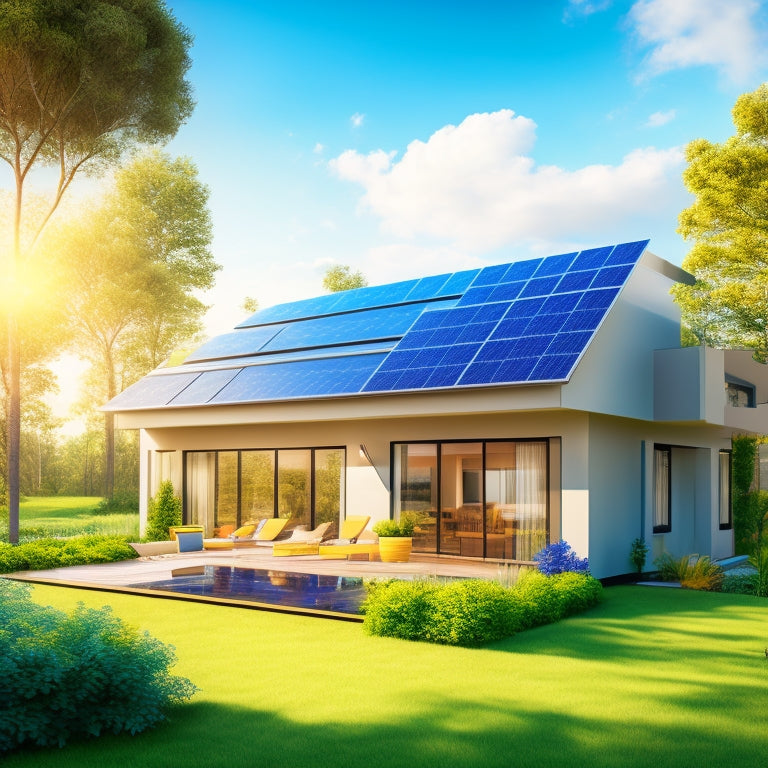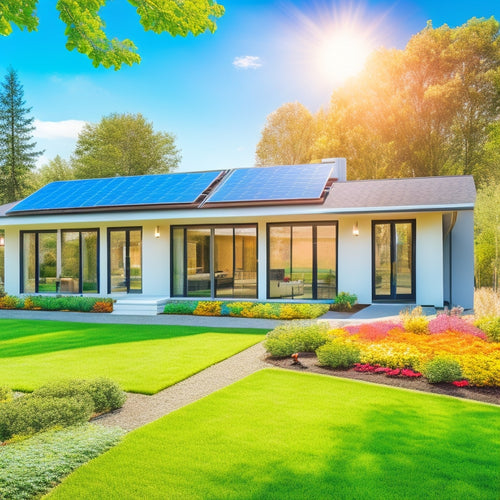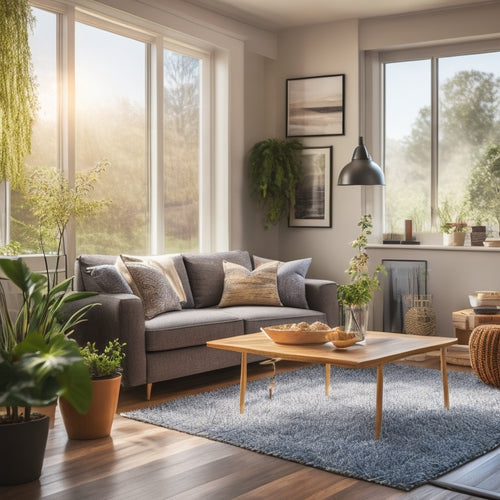
10 Essential Steps for Building a Solar Powered Home
Share
As you initiate the process of building a solar-powered home, you'll need to follow 10 essential steps to guarantee a reliable and efficient energy system. First, assess your energy needs by tracking your daily habits and appliances, then choose a building site with ideal sunlight exposure. Design your home with passive solar principles, select the right solar panel type, and determine your battery storage needs. Next, plan your electrical system layout, install solar panel mounting, and decide whether to connect to the grid or not. Implement energy efficiency measures, and finally, inspect and test your system. By following these steps, you'll be well on your way to utilizing the power of the sun - and there's much more to investigate to make your dream a reality.
Key Takeaways
- Assess your energy needs by tracking daily habits, appliances, and routines to determine required solar panel array size and battery storage capacity.
- Choose a building site with ideal sunlight exposure, avoiding shaded areas and high wind speed locations, and ensure compliance with local building codes.
- Design your solar home with energy efficiency and grid independence in mind, incorporating passive solar design principles and thermal mass materials.
- Select the right solar panel type based on space availability, efficiency ratings, and budget, and determine battery storage needs for backup power during low solar periods.
- Plan your electrical system layout to ensure efficient energy distribution, considering electrical panel capacity, wiring, and circuit breaker needs for safe operation.
Assess Your Energy Needs
Your energy consumption patterns play a significant role in determining the size and complexity of your solar-powered home. To guarantee ideal solar energy efficiency, you need to accurately evaluate your energy needs. Start by tracking your current energy usage, including your daily habits and appliance usage. This will help you identify areas where you can reduce your energy consumption and enhance your solar energy system.
Consider the number of occupants, their daily routines, and the appliances you plan to power. Don't forget to account for lighting, heating, and cooling systems. You'll also need to factor in the energy required for charging electric vehicles, if applicable.
By understanding your energy needs, you can determine the required solar panel array size, battery storage capacity, and overall system configuration.
Embracing renewable energy sources demands a thorough understanding of your energy requirements. A well-designed solar-powered home not only reduces your carbon footprint but also minimizes your reliance on the grid.
Choose a Building Site
Accurate energy needs assessment sets the stage for a well-designed solar-powered home.
Now, it's time to choose a building site that complements your energy goals. You'll want to select a site that receives ideal sunlight throughout the year. Reflect on the site orientation, considering the direction your solar panels will face. A south-facing orientation is ideal, as it receives the most direct sunlight.
However, you'll also need to reflect on the environmental impact of your building site. Look for areas with minimal shading from trees or other structures, and avoid sites with high wind speeds that could affect your solar panel's performance.
Additionally, verify your site isn't prone to natural disasters like floods or landslides.
When evaluating potential sites, assess the local building codes and zoning regulations. Some areas may have restrictions on the type of solar panels you can install or the height of your roof.
Design Your Solar Home
Designing a solar-powered home requires careful evaluation of several key factors, including the size and layout of the building, the type and placement of windows, and the insulation and construction materials used.
You'll want to optimize your home's design to maximize its energy efficiency and reduce its reliance on the grid. This means incorporating passive solar design principles, such as orienting your home towards the south to capture natural light and heat, and using thermal mass materials to absorb and release heat.
You'll also need to reflect on solar home aesthetics, balancing functionality with visually appealing design elements. By carefully selecting materials and design features, you can create a home that not only generates its own power but also looks great doing it.
Think about using large south-facing windows to let in natural light, and incorporate overhangs or awnings to reduce summer heat gain.
With careful planning, you can create a solar home that's both efficient and beautiful.
Select Solar Panel Type
Select Solar Panel Type
Three primary types of solar panels are available for residential use: monocrystalline, polycrystalline, and thin-film. You'll need to choose the one that best suits your solar power needs.
Monocrystalline panels are the most efficient, with an average efficiency rate of 20%. They're also the most expensive.
Polycrystalline panels, on the other hand, have an average efficiency rate of 18% and are more budget-friendly.
Thin-film panels are the least efficient, with an average efficiency rate of 12%, but they're also the most affordable.
When deciding between monocrystalline and polycrystalline panels, consider the space available for installation. If you have limited roof space, monocrystalline panels might be the better choice since they produce more power per square foot.
However, if you have ample space, polycrystalline panels can provide similar performance at a lower cost.
Solar panel efficiency is vital, as it directly affects the amount of energy you can generate. Look for panels with high efficiency ratings to maximize your power output.
Additionally, consider the warranty and durability of the panels, as well as their compatibility with your inverter and mounting system.
Determine Battery Storage Needs
When sizing up your solar powered home, evaluating your battery storage needs is crucial, as it directly impacts the reliability and efficiency of your system. A well-designed battery storage system guarantees a steady supply of power during periods of low solar irradiance or at night.
To determine your battery storage needs, you'll need to assess your energy requirements, factoring in elements such as your energy usage patterns, the size of your solar panel array, and the desired level of autonomy. A general rule of thumb is to size your battery capacity to provide at least 2-3 days of autonomy during periods of low solar irradiance.
| Factor | Consideration | Impact on Battery Storage Needs |
|---|---|---|
| Energy usage patterns | Peak demand hours, daily energy usage | Increased battery capacity for high energy usage |
| Solar panel array size | Number of panels, panel efficiency | Reduced battery capacity for larger arrays |
| Autonomy level | Desired number of days of backup power | Increased battery capacity for higher autonomy levels |
Plan Electrical System Layout
With a well-sized battery storage system in place, you can now focus on planning the electrical system layout, an essential step in building a solar powered home that guarantees efficient energy distribution and minimizes potential electrical hazards.
This involves determining the ideal solar panel placement to guarantee maximum energy production and identifying the electrical loads that require power. You'll need to conduct an electrical load analysis to calculate the total power requirements of your home, including lighting, heating, and cooling systems, appliances, and other devices.
This will help you design an electrical system that can handle the maximum power demand. You'll also need to take into account the electrical panel's capacity, wiring, and circuit breaker requirements.
A well-planned electrical system layout guarantees that your solar power system operates efficiently and safely, providing you with reliable power when you need it.
Install Solar Panel Mounting
Across your roof, a sturdy foundation awaits the solar panels that will capture the sun's energy to power your home. Installing solar panel mounting is a vital step in utilizing that energy. You'll need to verify your mounting hardware is securely fastened to your roof, considering factors like wind resistance and weatherproofing.
| Mounting Type | Solar Panel Orientation | Benefits |
|---|---|---|
| Fixed Mount | South-facing, tilted at 30-40° | Ideal energy capture, easy installation |
| Adjustable Mount | Adjustable tilt, south-facing | Seasonal energy maximization, flexible installation |
| Tracking Mount | Changing tilt and orientation | Maximum energy capture, advanced installation |
When selecting your mounting hardware, consider the type of roof you have (asphalt, metal, or tile), the local building codes, and the manufacturer's recommendations. Verify your mounting system is compatible with your solar panels and can support their weight. Proper installation will guarantee a safe and efficient solar-powered home.
Connect to the Grid or Not
Now that your solar panels are securely mounted, it's time to decide how you'll employ their energy - will you connect to the grid or go off-grid? This decision will greatly affect your solar powered home's functionality and your energy independence.
Connecting to the grid offers several benefits, including the ability to sell excess energy back to the utility company and offset your energy costs. This setup also allows you to draw power from the grid when your solar panels aren't producing enough energy, guaranteeing a steady supply.
Additionally, grid benefits include access to maintenance and repair services, as well as the potential for net metering.
On the other hand, going off-grid provides complete energy independence and can be more cost-effective in the long run. Off-grid advantages include not having to pay for grid connection fees or utility bills, and having a reliable source of energy during grid outages.
However, this option typically requires a larger solar panel system and energy storage solutions, such as batteries, to guarantee a steady supply of power. Evaluating these options carefully will help you make an informed decision that suits your energy needs and budget.
Ensure Energy Efficiency Measures
You'll want to reduce energy consumption by selecting energy-efficient appliances and lighting, as well as optimizing your home's insulation to minimize heat loss and gain.
This won't only reduce your reliance on the grid but also guarantee that your solar power system can meet your energy needs.
Reduce Energy Consumption
Several key factors contribute to the overall energy efficiency of a solar-powered home, and reducing energy consumption is a crucial step in the process.
You'll want to focus on implementing energy-saving techniques to minimize your reliance on the grid and maximize your solar power output.
To reduce energy consumption, consider the following:
-
Upgrade to smart appliances: Replace traditional appliances with energy-efficient, smart alternatives that can be controlled and monitored remotely. This will help you identify areas of high energy usage and make adjustments accordingly.
-
Improve lighting efficiency: Install LED light bulbs, which use notably less energy than traditional incandescent bulbs. You can also consider installing occupancy sensors or timers to reduce lighting usage when not needed.
-
Optimize your HVAC system: Verify your heating, ventilation, and air conditioning (HVAC) system is properly sized for your home and consider upgrading to an energy-efficient model. Regular maintenance and filter replacements can also help reduce energy consumption.
Optimize Home Insulation
Proper insulation is vital to maintaining a comfortable living space while minimizing energy consumption. As you design your solar-powered home, it's important to select high-performance insulation materials that enhance thermal performance. This will help reduce heat gain during summer and heat loss during winter, resulting in significant energy savings.
You should consider using insulation materials with high R-values, such as fiberglass, cellulose, or spray foam, in your walls, floors, and ceilings. Make sure that all gaps and cracks are sealed to prevent air leaks, which can compromise the effectiveness of your insulation.
Additionally, consider using radiant barrier insulation in your attic to reflect heat rather than absorb it.
When choosing insulation materials, look for products with high recycled content, low VOCs, and durability. It's also important to verify that your insulation is installed correctly to achieve the best thermal performance.
Inspect and Test the System
With the solar panel installation complete, turn your attention to inspecting and testing the system to confirm it's functioning as efficiently and safely as possible.
You've invested time and resources into building a solar-powered home, and now it's essential to ascertain the system is performing at its best.
Inspect the system's electrical connections, mounting systems, and wiring to identify any potential issues.
Perform tests to verify the system's voltage, current, and power output match the manufacturer's specifications.
This step is vital in preventing electrical shock, fires, or other hazards.
- Verify the system's performance monitoring system is accurately tracking energy production and consumption.
- Schedule regular system maintenance to identify and address potential issues before they escalate.
- Conduct routine inspections to confirm the system remains compliant with local building codes and safety standards.
Frequently Asked Questions
Can I Use Solar Power for Heating My Swimming Pool?
You can definitely use solar power to heat your swimming pool, and it's a great idea! Solar pool heaters can provide significant benefits and savings by utilizing free energy from the sun to warm your pool water.
How Do I Handle Solar Panel Maintenance and Repair?
Get down to brass tacks and prioritize solar panel maintenance: you'll be checking in regularly on your system's performance, employing effective cleaning techniques, and conducting thorough panel inspections to guarantee peak energy harvesting and extend its lifespan.
Are Solar-Powered Homes More Prone to Lightning Strikes?
You're wise to wonder if solar-powered homes attract lightning; fortunately, they don't. However, you still need to prioritize lightning protection and solar safety by installing surge protectors and following strict safety protocols to minimize risks.
Can I Sell Excess Energy Back to the Utility Company?
As you capture the sun's power, you'll likely wonder: can you sell excess energy back to the utility company? Yes, with net metering benefits, you can! You'll earn energy credits, offsetting your energy bills, and even selling excess back to the grid - a win-win for you and the planet!
Will a Solar-Powered Home Increase My Property Value?
You'll be pleased to know that a solar-powered home can enhance your property value, as a higher property appraisal is likely due to the long-term energy savings and increased appeal to eco-conscious buyers.
Conclusion
You've successfully built a solar-powered home, utilizing the power of the sun to reduce your carbon footprint. According to the National Renewable Energy Laboratory, a typical solar-powered home can save up to $400 annually on electricity bills. This statistic highlights the long-term benefits of investing in renewable energy, not just for the environment, but also for your wallet. Now, enjoy your sustainable and energy-efficient abode, knowing you're making a positive impact on the planet.
Related Posts
-

How Solar Panels Increase Property Value
Installing solar panels considerably increases your property value by improving energy efficiency and attracting eco-...
-

Innovative Sustainable Materials for Energy-Efficient Homes
Innovative sustainable materials enable you to create energy-efficient homes while promoting environmental responsibi...
-

Energy-Efficient Home Upgrades for Cost Reduction
To reduce costs with energy-efficient home upgrades, focus on essential improvements like smart thermostats, energy-e...


